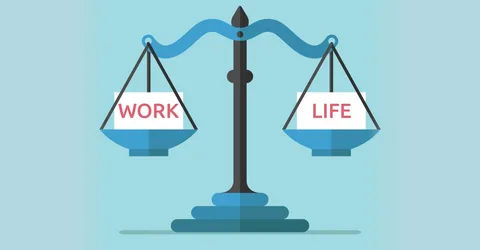Table of Contents
ToggleIntroduction
In today’s fast-paced world, maintaining a healthy work-life balance can often seem like an impossible feat. Technological advancements, while enabling efficiency and connectivity, also blur the line between work and personal life. This article delves into the concept of work-life balance, examining its importance and offering practical strategies to work smarter and live better. We explore how to achieve equilibrium between professional commitments and personal life, ensuring you have the time and energy to invest in the activities and relationships that matter most to you. So, let’s embark on this journey towards a balanced and fulfilling life!

Work-Life Balance
Work-life balance refers to the equilibrium that an individual needs between time allocated for work and other aspects of life. Areas of life other than work-life can include personal interests, family, and social or leisure activities. The ‘balance’ between these elements will vary for each person, but at its core, it is about having a measure of control over when, where, and how you engage with your work and personal life.
Importance of Work-Life Balance
Work-life balance is crucial for a multitude of reasons. It not only aids in reducing stress and preventing burnout in the workplace but also plays a critical role in strengthening the physical, emotional, and mental well-being of an individual. A good work-life balance enhances productivity, fosters personal growth, and leads to a more satisfying life. It allows individuals to focus on their personal lives as much as their professional growth, ensuring they do not neglect the essential aspects that contribute to their overall happiness and well-being.
Evolution of Work-Life Balance
Historical Perspective
Historically, the concept of work-life balance was significantly different from today’s understanding. In the era of the Industrial Revolution, work was often physically demanding and time-consuming, leaving little room for leisure or family time. As societies evolved and work transitioned from manual labor to office jobs, the importance of personal time and leisure began to gain recognition. Concepts like the eight-hour workday and the weekend emerged, signifying society’s growing awareness about the necessity of balancing work and personal life.
Modern Challenges and Trends
In the modern era, the advent of technology, globalization, and the shift towards a 24/7 work culture have posed new challenges to work-life balance. The lines between work and personal life have blurred, with many people taking their work home, digitally. However, there’s also a growing trend towards flexible working hours, remote work, and an increased emphasis on mental health. Companies today are recognizing the importance of employee well-being and are implementing policies to ensure a healthy balance between work and personal life.
Understanding the Work Landscape
Traditional 9-to-5 Work Culture
The traditional 9-to-5 work culture refers to a work schedule that starts at 9 a.m. and ends at 5 p.m., typically with a one-hour lunch break. This culture is rooted in an office-based environment where employees perform their duties at a designated workplace. The characteristics of this culture include a fixed work schedule, physical presence in the office, clear boundaries between work and personal life, and an emphasis on face-to-face communication.
Pros and Cons
The traditional 9-to-5 work culture carries several advantages. It provides a structured work environment that can enhance focus and productivity. Clear work hours, also help maintain a distinct separation between professional and personal life, fostering work-life balance. However, this culture also has its drawbacks. It can limit flexibility, making it difficult for employees to manage personal responsibilities during work hours. Furthermore, the obligation to be physically present at the office may inadvertently neglect the potential benefits offered by remote and flexible work arrangements.
Remote Work and Flexible Schedules
The advent of the digital age has introduced new ways of working that deviate from the traditional 9-to-5 model, one of which is the concept of remote work and flexible schedules.
Rise of Remote Work
In recent years, remote work has been on the rise, driven by advancements in technology that allow individuals to work virtually from anywhere. The COVID-19 pandemic has further accelerated this trend, with many companies shifting to remote work arrangements to safeguard the health of their employees while maintaining business operations. Remote work provides flexibility by eliminating commuting time and allowing employees to work from a location where they feel most comfortable and productive.
Benefits and Challenges
Remote work comes with a plethora of benefits. It can increase job satisfaction, improve work-life balance, and lead to higher productivity due to fewer distractions and interruptions. However, it’s not without its challenges. Remote workers may feel isolated and struggle to stay connected with their teams. There’s also the risk of overworking, as the boundaries between work and personal life can blur when working from home. Additionally, dealing with technical issues and maintaining self-discipline and motivation can be difficult in a remote work setup.
Impact of Work-Life Imbalance
Health Consequences
An imbalance between work and personal life can have severe consequences on an individual’s physical, mental, and emotional health. Prolonged periods of stress due to overworking or neglecting personal responsibilities can lead to burnout, fatigue, and even chronic health conditions like hypertension and depression.
Physical Health
An imbalance between work and personal life can have serious implications for physical health. Prolonged periods of stress, often associated with overwork, can lead to a range of health problems, including headaches, sleep disorders, an impaired immune system, and an increased risk of heart disease. Furthermore, individuals who neglect their personal lives for work often overlook the importance of regular exercise and healthy eating habits, which can contribute to obesity, diabetes, and other lifestyle-related diseases.
Mental Health
The mental health consequences of work-life imbalance are equally concerning. Chronic work stress can lead to mental health disorders such as anxiety and depression. The inability to disconnect from work can interfere with relaxation and leisure activities, depriving individuals of essential outlets for stress relief. Moreover, constantly juggling work responsibilities with personal commitments can lead to feelings of being overwhelmed and can increase the risk of burnout—a state of chronic physical and emotional exhaustion often accompanied by feelings of cynicism and detachment from work.
Strain on Relationships
Work-life imbalance not only impacts individual health but can also put a strain on personal relationships.
Family Dynamics
Overwork and the inability to disconnect from professional responsibilities can significantly impact family dynamics. Time spent on work beyond regular hours often encroaches upon the time intended for family activities and interaction. This can lead to feelings of neglect and resentment among family members. Children, in particular, may feel the absence of a working parent in their daily routines and during significant events. Moreover, the stress experienced by overworked individuals can create a tense home environment, affecting the overall harmony and emotional well-being of the family.
Social Connections
Similarly, social connections can suffer in the face of work-life imbalance. When work dominates an individual’s schedule, it leaves little time for social activities and maintaining relationships with friends. This lack of social interaction can exacerbate feelings of isolation and stress, causing a further decline in mental health. It can also lead to a loss of support networks that are vital for emotional well-being. Therefore, a balanced approach to work and personal life is essential for maintaining healthy social connections.
Strategies for Achieving Work-Life Balance
Time Management Techniques
Efficient time management is pivotal in achieving a balanced work-life dynamic. It involves allocating time wisely to ensure both professional and personal goals are met.
Prioritization
Prioritizing tasks is a crucial time management strategy. It involves determining the importance and urgency of tasks and focusing on those that are most critical. Prioritization helps reduce feelings of being overwhelmed, increases productivity, and ensures that key deadlines are met. Tools such as the Eisenhower Matrix can aid in this process by categorizing tasks into four quadrants based on their urgency and importance.
Setting Boundaries
Setting boundaries is another important aspect of time management. This involves establishing clear lines between work and personal life and ensuring one does not encroach on the other. It might mean setting specific work hours and resisting the temptation to check work emails or take work calls outside these hours. It may also involve setting aside dedicated time for leisure and relaxation, ensuring that work stress does not impede on personal life.
Technology and Work-Life Integration
In the modern era, technology plays an instrumental role in both personal and professional realms. It has the potential to both help and hinder work-life balance, depending on how we use it.
Leveraging Technology for Balance
Utilizing technology effectively can aid in achieving a healthy work-life balance. Various digital tools and apps can assist in managing time and tasks more efficiently. For example, calendar apps can help schedule work and personal activities, ensuring neither domain is neglected. Likewise, project management apps can streamline workflow, increasing productivity and freeing up time for leisure and relaxation. Additionally, technology can facilitate flexible work arrangements, such as remote work, that can significantly enhance work-life balance.
Establishing Digital Boundaries
While technology offers numerous benefits, it’s important to be mindful of its potential drawbacks. The constant connectivity provided by digital devices can blur the boundaries between work and personal life, leading to the risk of overwork and stress. Therefore, establishing digital boundaries is crucial. This might mean setting specific times to check work emails or using app blockers to limit time spent on work-related apps outside work hours. Regular digital detoxes, periods away from digital devices, can also be beneficial in maintaining a healthy balance.

Role of Employers in Promoting Work-Life Balance
Employers have a key role to play in fostering a culture that prioritizes work-life balance. Adopting flexible work policies, providing comprehensive well-being programs, and demonstrating a clear commitment to employee health and well-being are just some of the ways employers can contribute to a balanced work environment.
Flexible Work Arrangements
Flexible work arrangements, such as remote work or flexible work hours, can significantly improve work-life balance. These policies allow employees to adjust their work schedules to accommodate personal commitments, reducing the pressure of juggling work and personal life.
Comprehensive Well-being Programs
Employers can also promote work-life balance through comprehensive well-being programs. These programs can include initiatives like stress management workshops, fitness programs, and mental health support services. These initiatives not only help employees manage their stress levels but also demonstrate the company’s commitment to employee well-being.
Fostering a Supportive Culture
Lastly, employers can promote work-life balance by fostering a supportive culture. This involves encouraging employees to take time off, discouraging after-hours work, and promoting open dialogue about work-life balance issues. By creating an environment where work-life balance is valued and prioritized, employers can help ensure employee satisfaction, reduce burnout, and enhance overall productivity.
FAQs
What is work-life balance?
Work-life balance refers to the equilibrium between professional responsibilities and personal life. It’s about finding a healthy balance between work commitments and personal interests, such as hobbies, physical activity, social interactions, and family time.
Why is work-life balance important?
Maintaining a healthy work-life balance is crucial not just for individual happiness and well-being, but also for overall productivity and performance at work. It helps prevent burnout, reduces stress, improves mental health, and enhances job satisfaction.
How can I improve my work-life balance?
Improving work-life balance often involves effective time management and setting boundaries between work and personal life. This could mean setting specific work hours, prioritizing tasks, and ensuring you allocate time for leisure and relaxation. Using technology wisely can also aid in managing tasks more efficiently.
Conclusion
Achieving a balanced work-life dynamic is less about scrambling to fit things in, and more about working smarter, and living better. Effective time management, prioritization, setting boundaries, and the prudent use of technology are fundamental to fostering this balance. Employers too have a pivotal role in creating environments that promote work-life balance through flexible work arrangements, well-being programs, and by cultivating a supportive culture. A healthy work-life balance is not a luxury, but a necessity, enhancing not only individual well-being and happiness but also overall workplace productivity. Remember, the goal is not to be perpetually busy but to live a fulfilling and balanced life.




















